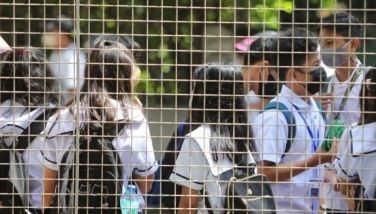What you need to know about the Abu Sayyaf
June 13, 2016 | 8:00pm

Let's take a look at how the Abu Sayyaf came to be.
File
MANILA, Philippines (First published April 27, 2016 7:44 p.m.) — Canadian Robert Hall was beheaded by the Abu Sayyaf on Monday, June 13, making him the latest victim killed in its spate of kidnap-for-ransom activities.
Hall was one of the four captives taken from the Holiday Oceanview Samal Resort on Samal Island last September 2015 along with Canadian John Ridsdel, Norwegian Kjartan Sekkingstad and Filipina Marites Flor. Of the four, the first to be beheaded was Ridsdel after his P300 million ransom deadline lapsed last April 25.
Abu Sayyaf has gained notoriety for profit-driven activities like extortion and kidnap-for-ransom for more than a decade.
And experts said the group has evolved into a criminal gang with the decline in its ideologically-motivated attacks.
Behind the formation of this group was Libya-educated Islam preacher Abdurajak Abubakar Janjalani.
Funded by fundamentalist organization Al Islamic Tabligh, Abdurajak went to Saudi Arabia and Libya in the 1980s to learn Arabic and deepen his knowledge of Islam. There he got radicalized and reportedly met and fought alongside Osama bin Laden against the Soviet invasion of Afghanistan.
His experiences in the Middle East were influential in his desire of establishing an Islamic state in Mindanao.
When he returned to Basilan, Abdurajak broke away from the Moro National Liberation Front (MNLF) and created the Abu Sayyaf or “father of the swordsman” in 1991, naming it after Afghan resistance leader Professor Abdul Rasul Sayyaf.
He recruited other disaffected MNLF members, exploiting divisions within the group over government negotiations.


Atrocities
Historical neglect and injustice in Mindanao helped in the emergence of the Abu Sayyaf as an alternative to the MNLF and the Moro Islamic Liberation Front.
Data from Philippine Statistics Authority for the first semester of 2015 showed that 11 of the 20 poorest provinces in the country are in Mindanao. These are Lanao del Sur, Sulu, Sarangani, Bukidnon, Maguindanao, Sultan Kudarat, Zamboanga del Norte, Agusan del Sur, North Cotabato, Lanao del Norte, and Camiguin.
Of the three Islamic separatist groups in the Philippines, the Abu Sayyaf may be the smallest but it is also the most extreme.
Soon after it was established, the Abu Sayyaf executed major attacks targeting Christians, government troops, and foreigners. It was listed as a terrorist organization by the US Department of State in 1997 and by the Australian National Security in 2002.
In 2001, the United Nations Security Council listed it as having associations with the Al-Qaeda, bin Laden or the Taliban.
Abu Sayyaf experienced a big blow in 1998 when Abdurajak was killed in a police shootout in Basilan.
Two factions were formed after his death. One was headed by Galib Andang alias Commander Robot and the other by Abdurajak’s brother Khadaffy.
The subsequent killings in 2005 and 2006 of these two leaders in clashes with government forces along with the deaths of other key figures led to the further fragmentation of the terror group.
It has become a loose group of 400 members, according to US estimates, with clan-based factions.
RELATED: Abu Sayyaf: Too many leaders
Abdul Basir Latip, the key financial officer of Abu Sayyaf, was also captured in 2009. He was in charge of moving funds from Al Qaeda to the Abu Sayyaf.
As funding from foreign sources declined in mid-1990s, it turned to kidnap-for-ransom and extortion to make money.
According to international security analyst Rommel Banlaoi, Abu Sayyaf membership rose 13 percent from 2014 to 2015 as it has money to offer to potential recruits. He said this in an interview over ANC.
According to international security analyst Rommel Banlaoi, Abu Sayyaf membership rose 13 percent from 2014 to 2015 as it has money to offer to potential recruits. He said this in an interview over ANC.


Where they are
The group trains and operates in the Zamboanga Peninsula and in the islands of Basilan, Jolo, and Tawi-Tawi.
Banlaoi said the Basilan faction of the Abu Sayyaf is more involved in Islamic propagation activities, while the Sulu faction is more involved in kidnap-for-ransom and extortion activities.
The Basilan faction led by Isnilon Hapilon also pledged allegiance to ISIS, a rival of Al Qaeda. But Defense Secretary Voltaire Gazmin said there is no formal ISIS organization in the Philippines.


BrandSpace Articles
<
>
- Latest
- Trending
Trending
Latest
Trending
Latest
Recommended





























